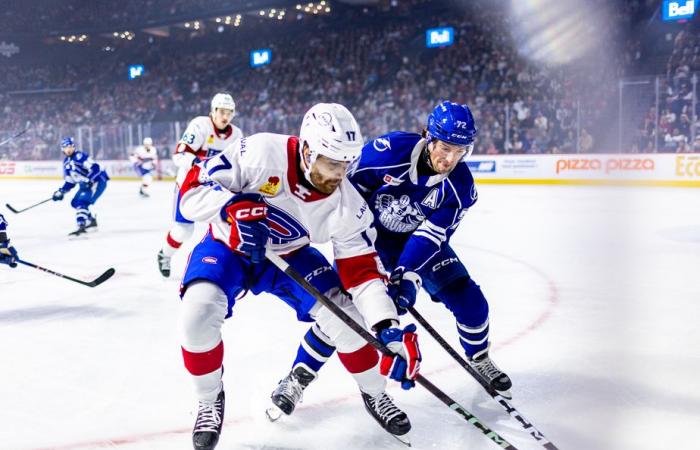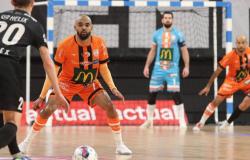For the partisan, the difference is subtle. Barely visible to the naked eye. But for players, the piece of equipment can save their lives.
Posted at 1:38 a.m.
Updated at 8:00 a.m.
In the American Hockey League, wearing a neck protector has been mandatory since the start of the season. An irritating change for some, despite the undeniable benefits.
A year ago almost to the day, Adam Johnson died at the age of 29. The center had his neck lacerated by the blade of an opponent’s skate during a Champions Cup match in England.
His death caused an earthquake in every locker room around the world.
“It was a shock,” admits Providence Bruins forward Jeffrey Viel, who was in Laval to face the Rocket. This calls many things into question. It makes you realize it could happen to you. »
“We played the same evening as him, at the same speed of play,” adds his teammate Frédéric Brunet. You never know if something will happen. »
PHOTO DOMINICK GRAVEL, LA PRESSE
Florian Xhekaj et Luke Tuch, you Rocket de Laval
For the Bruins, Johnson’s death had an immediate impact. “A teammate saw that I had a neck protector in my bag, which I was not wearing. I left it to him. I didn’t yet know about Johnson…” says Frédéric Brunet.
A few days later, the organization ordered 100 neck protectors for the entire team. She “strongly” encouraged her players to wear one, explains Brunet.
It took a year for the American League to impose the piece of equipment. The league then joined forces with the International Ice Hockey Federation (IIHF), which requires players to wear it during its competitions. The Western Junior League (WHL) also followed suit, imitating the QMJHL and the OHL, which already required it.
The trend hasn’t reached the NHL, where wearing a neck guard is “strongly encouraged” but still optional.
It must be said that imposing a piece of equipment represents a colossal task in a conservative world like that of hockey. Players follow particular habits and are very picky when it comes to their equipment. A little thing can disrupt their habits. Talk to Rocket defenseman Tyler Wotherspoon, who, like many other veterans, dreaded wearing the neck guard.
“At first I thought it would bother me. To be honest, it’s been a smooth transition,” said the 31-year-old.
“The guys who have been in the league for a long time, when they had to put on a neck protector, they didn’t find it fun, they felt stuck. They say it will take them time to adjust,” confirms Frédéric Brunet.
Jeffrey Viel admits that he had to test “two or three different models” before getting used to it. “But it’s like the mouth guard: you get used to it. I imagine it was the same for the guys who didn’t have the visor, when they imposed it,” he says.
“If it can reassure my mother”
For the youngest, the transition goes smoothly. Most players in their early 20s wore the neck guard in the minors, not that long ago. The adaptation was therefore immediate.
“We want to make the game safer, the least we can do is wear a neck protector,” explains Rocket forward Luke Tuch. The game is fast, the guys skate at over 30 km per hour, with blades that are almost knives at their feet. »
“I think it gives everyone a little sense of security. It takes a little weight off our shoulders compared to what could happen on the ice,” says Brunet.
It could therefore be young people, once called up to the NHL, who will spread the wearing of neck guards. “The more players wear it, the more the guys get used to it, the more they will wear it in the NHL,” said Jeffrey Viel. It’s a process. »
But like any process, breaking habits can take time. For example, even though Jeffrey Viel praises wearing a neck guard, he doesn’t believe he would wear it if he was called upon to play in the NHL again.
“For now, I would say no,” he says, after a long hesitation. But I would think about it, for sure. »
Frédéric Brunet would not hesitate in the event of a recall. “I didn’t feel stressed on the ice without a neck guard, but if it reassures my mother, I’m going to wear one. »
“I’ve gotten used to it, so the neck protector won’t go anywhere by the end of my career,” he concludes, in front of the broad smile of Maman Brunet, who is probably reading these lines.
An imposition violated
Two Quebecers tragically died of neck lacerations during hockey matches in the 1980s. In response, the wearing of neck guards became mandatory for minor-age players in 1986, and for players of all ages who do not. did not play among the pros in 1992. Despite this imposition, many Quebecers still risked their lives during the 2013-2014 season. At that time, only 45% of players in the province wore neck guards, according to a study by the Quebec Association of Arenas and Recreational and Sports Facilities (AQAIRS).







